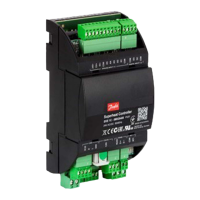8.1.5 Application alarms
Table 59: Application alarms
Trigger (how the alarm IS
raised)
Low S4 media outlet
temperature
Injection active and Min S4
function active and S4 below
MIN S4 set point - Low Min S4
band and Low Min S4 delay ex-
pired
Injection not active or Min S4
function disabled or S4 above
MIN S4 set point - Low Min S4
band
Media out temperature is below alarm lim-
it and alarm delay has expired.
High evaporation
pressure (MOP)
Injection active and Mop active
and Te higher than mop set
point + MOP alarm dierential
and MOP alarm delay expired
Injection not active or Mop dis-
abled or Te below mop set
point + MOP alarm dierential
Pe /Te is higher than alarm limit and alarm
delay has expired.
Low evaporation
pressure (LOP)
Injection active and Lop active
and Te lower than lop set point
- LOP alarm dierential and
Cond temp alarm delay expired
Injection not active or Lop disa-
bled or Te above lop set point +
LOP alarm dierential
Pe /Te is lower than alarm limit and alarm
delay has expired.
High condensing
temperature
Injection active and HCTP ac-
tive and Tc above HCTP set
point + Cond. temp.alarm dif-
ferential and LOP alarm delay
expired
Injection not active or HCTP
disabled or Tc below HCTP set
point + Cond. temp.alarm dif-
ferential
Pc / Tc is higher than alarm limit and alarm
delay has expired.
Injection active and SH above
SH reference +High SH alarm
dierential and High SH alarm
delay expired
Injection not active or SH below
SH reference +High SH alarm
dierential
Superheat is higher than alarm limit and
alarm delay has expired.
Injection active and SH below
SH reference - low SH alarm dif-
ferential and low SH alarm de-
lay expired
Injection not active or SH above
SH reference - low SH alarm dif-
ferential
Superheat is below alarm limit and alarm
delay has expired.
Injection active and OD higher
than max OD - 5% for more
than 90 96 of Lack of capacity
alarm delay time
Injection not active or OD high-
er OD - 5% in less than 88% for
Lack of capacity alarm delay
time
Valve is running close to full capacity for
long time.
Error in Heat/Cold in
thermostat mode
Use of DI as H/C function in
thermostat mode.
Avoid H/C function in DI while
in thermostat mode.
H/C function not available in thermostat
mode.
(1)
• Length of monitoring window for High superheat detection can be adjusted using parameter [A108 – High SH alarm delay]. If the parameter
is set to 0 the function is disabled.
• The high superheat limit is dened by the user through parameter [A109 – High SH alarm dierential] High superheat limit= SH ref+ High SH
alarm dierential.
(2)
• Length of monitoring window for Low superheat detection can be adjusted using parameter [A110 – Low SH alarm delay]. If the parameter
is set to 0 the function is disabled.
• The high superheat limit is dened by the user through parameter [A998 - Low SH alarm dierential]
Low superheat limit= SH ref- Low SH alarm dierential, If Low superheat limit is lower than SH close set point, then
Low superheat limit= SH close set point.
(1)
• Length of monitoring window for High superheat detection can be adjusted using parameter [A108 – High SH alarm delay]. If the parameter
is set to 0 the function is disabled.
• The high superheat limit is dened by the user through parameter [A109 – High SH alarm dierential] High superheat limit= SH ref+ High SH
alarm dierential.
(2)
• Length of monitoring window for Low superheat detection can be adjusted using parameter [A110 – Low SH alarm delay]. If the parameter
is set to 0 the function is disabled.
• The high superheat limit is dened by the user through parameter [A998 - Low SH alarm dierential]
Low superheat limit= SH ref- Low SH alarm dierential, If Low superheat limit is lower than SH close set point, then
Low superheat limit= SH close set point.
8.1.6 Thermostat alarms
Table 60: Thermostat alarms
Trigger (how the alarm IS
raised)
Thermostat active and thermo-
stat temperature (s4/ S3) above
actual reference + Upper tem-
perature alarm for Temperature
alarm delay time
Thermostat not active or ther-
mostat temperature (s4/S3) be-
low actual reference + Upper
temperature alarm
Thermostat temperature is higher than
alarm limit and alarm delay has expired
Thermostat active and thermo-
stat temperature (s4/ S3) below
actual reference - lower tem-
perature alarm for Temperature
alarm delay time
Thermostat not active or ther-
mostat temperature (s4/S3)
above actual reference - lower
temperature alarm
Thermostat temperature is lower than
alarm limit and alarm delay has expired
© Danfoss | Climate Solutions | 2022.06 BC398828796060en-000101 | 75
Superheat controller, Type EKE 1A, 1B, 1C, 1D

